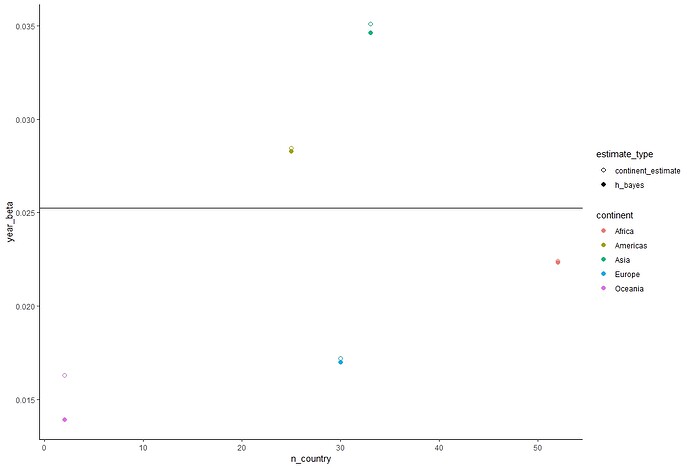Below is a reprex where I use the gapminder data to fit a simple model by continent.
I am curious how people could solve the problem of "shinking" coefficients to one or more group level means. I have heard that brms and lme4 are good libraries for this kind of analysis. Also, what is the difference between some of these shrinkage algorithms and simply doing some kind of weighted average?
library(gapminder)
library(tidyverse)
library(ggrepel)
#> Warning: package 'ggrepel' was built under R version 3.5.2
# simple lifeExp model
lifeExp_model <- function(df) {
lm(lifeExp ~ year, data = df) %>%
broom::tidy() %>%
select(term, estimate)
}
# change factors to char
gapminder$country <- as.character(gapminder$country)
gapminder$continent <- as.character(gapminder$continent)
# continent model (grouped)
continent_fit <- gapminder %>%
group_by(continent) %>%
nest() %>%
mutate(model = map(data, lifeExp_model)) %>%
unnest(model) %>%
rename(continent_term = term, continent_estimate = estimate)
# pooled
pooled_fit <- gapminder %>%
nest() %>%
mutate(model = map(data, lifeExp_model)) %>%
unnest(model) %>%
rename(pooled_term = term, pooled_estimate = estimate)
# number of observation per continent
n_obs <- gapminder %>%
group_by(continent) %>%
summarise(n_country = n_distinct(country))
# gouped and pooled fit
gnp_fit <- continent_fit %>%
inner_join(n_obs) %>%
inner_join(pooled_fit, by = c( "continent_term" = "pooled_term"))
#> Joining, by = "continent"
gnp_fit %>%
filter(continent_term == "year") %>%
ggplot(aes(x = n_country, y = continent_estimate )) +
geom_hline(aes(yintercept = pooled_estimate)) +
geom_point() +
ggrepel::geom_label_repel(aes(label = continent))+
theme_classic()

Created on 2019-02-02 by the reprex package (v0.2.1)
